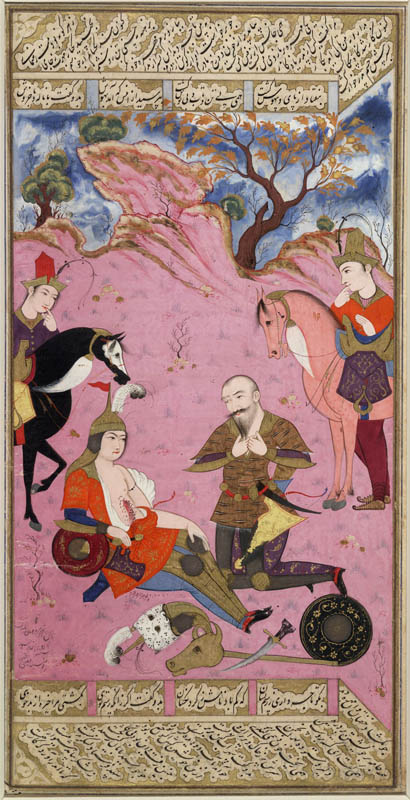Rostam Slays Soḥrāb
The young Soḥrāb is seated with his legs outstretched on the ground in the lower left of the composition. He still wears his pointed steel helmet and leg protectors, and leans on his shield with his right arm. His open and half-removed shirt reveals the left side of his torso with a wound just below the heart, which is gushing blood. Rostam, bareheaded but still wearing his tiger-skin coat, kneels in the right foreground before Soḥrāb, gripping his own lapels in a sign of anguish. His leopard-skin headdress, dagger, and bullheaded mace lie in the near foreground. Almost symmetrically disposed behind each of the two main figures are the forequarters of a horse and groom: one Soḥrāb’s, one Rostam’s. Each groom makes the same gesture, placing his forefinger to the lips. The ground is barren and broken only by little patches of grass evenly dispersed, and by a few twigs intended to represent shrubbery. In the far background, near the top of the picture, is a craggy rock formation, a leafless contorted tree, and a turbulent sky.
Painting: 20.0 x 14.1 cm.
Painting with text and frame: 28.7 x 14.8 cm.
Fourteen lines of text written on a diagonal, and a single line of four-column text are located above the painting, and below the painting another single line of four-column text and fourteeen lines written on the diagonal but at the opposite incline. Gilt interlinear decoration permeates the text. No indications of damage or retouching. The painting is signed and dated in the lower left foreground by Moʿin Moṣavver, Ramażān 1059/September 1649.
Location:
British Museum, London, #1922-7-11-02
Painting references:
Kühnel, Pantheon_1942, fig.5.
Stchoukine, SA_1964, p.64 and pl.LXXXVI.
Canby, PP_1993, p.109, no.73.
Cambridge Shahnameh Project
Text references:
Warner, II, pp.172-74; Mohl, II, pp.133-40; Levy, p.79.
Robert Eng
Last Updated: March 17, 2011
Originally published: March 17, 2011
